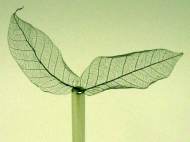Researchers transformed a leaf skeleton into iron carbide
 Nature’s fine structures are also suitable for technical applications because they exist in a numerous variety of forms, they usually display high mechanical stability and, due to their large surfaces, they provide suitable templates for catalysts and electrodes. Researchers from the Max Planck Institute of Colloids and Interfaces in Potsdam have succeeded in converting the filigree skeleton of a leaf into iron carbide by using a very simple method.
Nature’s fine structures are also suitable for technical applications because they exist in a numerous variety of forms, they usually display high mechanical stability and, due to their large surfaces, they provide suitable templates for catalysts and electrodes. Researchers from the Max Planck Institute of Colloids and Interfaces in Potsdam have succeeded in converting the filigree skeleton of a leaf into iron carbide by using a very simple method.
Materials scientists are interested in metal carbides because they are magnetic, conduct electricity and can withstand both high temperatures and mechanical stress. However, due to the stability of the material, researchers weren’t able to shape it into a specific form. The Potsdam-based chemists have solved this problem by dipping the leaf skeleton of leaves from a rubber tree into an iron acetate solution. They then air-dried the soaked skeleton at 40 degrees Celsius before treating it with nitrogen gas and heating it to 700 degrees Celsius.
“The structure was conserved down to the last detail”, said Zoe Schnepp, who carried out the experiment. “The skeleton provides both the basis for the form and the carbon for the reaction. As a result, we can convert the organic substance in just one step. This is what distinguishes our method from other techniques which also use biological forms as templates for inorganic structures.”
When heated, the iron acetate in the leaf skeleton is converted into iron oxide, which is then reduced by the carbon in the leaf skeleton to iron carbide. Researchers have been producing metal oxides on the basis of natural materials like leaves for some time now.
“One team has already succeeded in generating silicon carbide from pre-treated natural materials”, said Schnepp. “We’ve now developed this process even further.”
To test whether the leaf was fully converted into iron carbide, the researchers hung it in an electrolytic cell as an anode. Oxygen from the cell bubbled at the leaf and hydrogen bubbles rose at the cathode. “The experiment confirms that most of the leaf was converted into iron carbide. Apart from that, it only contains a bit of carbon,” says Zoe Schnepp. The researchers also used a permanent magnet to demonstrate that the leaf had acquired the magnetic characteristics of the iron carbide.
The new method should function with all natural carbonaceous materials. “We would now like to test it on other materials”, said Schnepp. “What is important about this study is that it shows how we can exploit nature’s formal variety to produce wafer-thin metal carbide structures in one simple step.”
You can find more information in the paper they published: “Biotemplating of Metal Carbide Microstructures: The Magnetic Leaf“.









I may say that man by nature is very innovative and with nature, man gets inspiration. It is mutual relationship. I love what you have posted and it simply shows that there are limitless ideas man can share with the rest of the world.